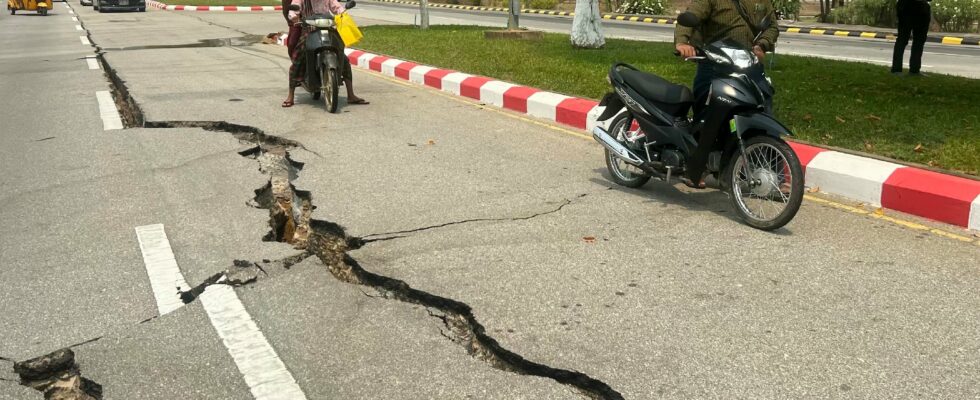A powerful earthquake of magnitude 7.7 struck the center of Burma on Friday, March 28, an earthquake whose tremors were felt to China and Thailand where a building of thirty floors collapsed in Bangkok, trapped around forty workers. Thai Prime Minister Paetongtarn Shinawatra said the capital in an emergency, while the Burmese junta launched a rare appeal for international aid.
The shallow earthquake occurred 16 kilometers northwest of the city of Sagaing, around 2:20 p.m. local time (07:20 French time), the American Geological Institute (USGS) announced. A replica of magnitude 6.4 rocked this area a few minutes later, according to the same source.
In the Burmese capital, in Naycyidaw, the roads were distorted under the effect of tremors and pieces of ceiling fell from buildings, AFP journalists found. If the human assessment is not immediately known, an important hospital in Naytyidaw deals with “many victims”, an official of the establishment told AFP. Faced with the extent of the damage, the junta returned to power in 2021 declared the state of emergency in six regions, and called for international aid.
A building collapses in Bangkok
Strong tremors have also been felt in neighboring Thailand, causing panic scenes in Bangkok where offices and stores have been evacuated. A 30 -storey building under construction collapsed in the Thai capital after the earthquake, a police official told AFP. Research started to find 43 workers blocked on the site, according to the emergency rooms.
“I heard the noise while I was sleeping at home, I ran as far away as possible in pajamas outside the building,” said Duangjai, a resident of the country’s second city, Chiang Mai (north-west), a prized destination for tourists and renowned for its temples. Sai, another resident of Chiang Mai, 76, was in a supermarket at the time of the earthquake. “I rushed outside the store with other customers,” he said. “It is the strongest shock that I felt in all my life”.
The tremors were also felt in the north and center of Thailand. In Bangkok, some metro services have been suspended. The Thai Prime Minister Paetongtarn Shinawatra immediately announced the summons of an “emergency meeting” in a message on X.
The particularly vulnerable population
AFP journalists were at the National Museum of Burma, in Naycyidaw, when the earthquake occurred, making the building walls tremble. Pieces fell from the ceiling and the walls cracked. Employees rushed to the outside, some crying, while others were trying to reach their loved ones by phone. The ground vibrated for thirty long seconds, before stabilizing.
Other tremors have also been felt in the Chinese province of Yunnan (Southwest), according to the Chinese agency in charge of earthquakes, which recorded a magnitude 7.9 shock.
India is ready to offer “all possible assistance” to Burma and Thailand, Prime Minister Narendra Modi said on Friday. “I asked our authorities to be available,” he wrote on social network X, saying “praying” for “the safety and health of all”.
The earthquakes are relatively frequent in Burma, where six earthquakes that have reached or exceeded a magnitude of 7 occurred between 1930 and 1956 near the sagaing flaw, which crossed the center of the country from north to south. In 2016, an earthquake of magnitude 6.8 had shaken the old capital, Bagan, in the center of the country, killing three people and causing the collapse of the walls of the temples of this tourist destination. In November 2012, an earthquake also of magnitude 6.8 struck the center of the country, killing 26 people and hundreds of injured.
The weakness of the infrastructure, the insufficient health services, especially in rural areas, the anarchic development of urbanized areas have made the population of the inhabited regions particularly vulnerable in the event of a natural disaster, according to experts.
